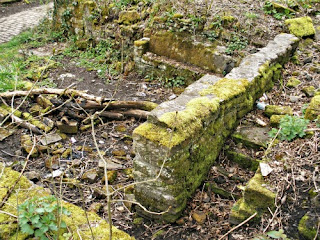This is the statue of John Bright (1811-1889) a native of Rochdale. Bright was
firstly the Liberal Mp for Manchester and, in 1858, he became the
member of Parliament for Birmingham. He was a reformer and also a major
campaigner for the repeal of the Corn Laws in 1839. Also, he was
a member of The Society of Friends (Quakers) and was a mill owner in Rochdale
(his father had earlier set up this very same mill). This very fine
statue of Bright, a local landmark, stands proudly at the western side
of Broadfield Park overlooking the esplanade and close to Rochdale Town
Hall.

Just a short distance further back up the path overlooking the esplanade at
the western side of Broadfield Park stands another interesting monument called
'The Dialect Writers Memorial' made of a red granite pedestal topped by an
obelisk that was erected here in 1900. This tall granite monument stands in
memory of the four Rochdale dialect writers, Edwin Waugh who died in 1890,
Oliver Ormerod died 1879, Margaret Lahee died 1895 and John Clegg who died in
1895. However, the most famous of these undoutedly was the renowned poet Edwin
Waugh born in 1817 and died 1890 the renowned Rochdale-born dialect poet and
author. The monument is very carefully inscribed with the various poems and
information on each of the writers' - along with their carved faces. It is
well-worth having a much closer look at - and, also perhaps taking rather more
time to read those interesting inscriptions. The photo shows the side
pertaining to Edwin Waugh with related information.

From here go on into Broadfield Park - passing close to the statue of Alderman
George Leach Ashworth (1823-1873), a former mayor of Rochdale. Opposite
the bandstand and close to the St Alban's Road (Ordnance Survey grid
reference SD.896 130) entrance where there is a curious round-shaped boulder,
made of andecite, that is thought to weigh somewhere
between five and seven tons. This is actually a relic of the last
Ice-Age about 11,000-13,000 years ago. Apparently it used to lie in a
field at Cown Top farm, on the moors above Rochdale, but it was given as
a gift to the park. The glacial erratic boulder was transported to the
Rochdale area in a retreating ice flow moving south from Borrowdale in the
Lake District and scraping along the western sides of the Pennines.

Continuing our ramble around Rochdale head out of Broadfield Park and to
Sparrow Hill where the beautiful Gothic ediface of St Chad's parish church can
be found. There was a church, of sorts, here back in the 1100s on what was
perhaps a Saxon site. Part of the square-shaped tower is thought to date back
to that period. But what we see today is a Gothic revivalist restoration of
the late 19th century. The building is though quite stunning. Above the main
entrance there is an imposing statue of Saint Chad, who is looking down.
This very fine statue of St Chad, bishop of Lichfield (d 672) looks down,
imposingly, from his splendidly carved niche above the main entrance to the
church.
Close to St Chad's parish church we can see the railed-off grave of Tim Bobbin
(John Collier) 1708-1786. He was born at Urmston near Manchester and spent
much of his life in and around Rochdale, indeed he was a teacher at
Milnrow. But Collier became a well-known Lancashire caricaturist and
satirical dialect poet. He would sell his drawings and poems in the inns of
Rochdale; his portraits of the folk who frequented these ale houses were often
of a comical nature. Many of these drawings and dialect poems are still known
to us today. Collier's gravestone with its worn epitaph is a pilgrimage site
for many Lancashire poets. The worn epitaph can just be made out and has,
apparently, a number of references to his wife Mary who he referred
to as Moll.

And now the final part of our ramble takes us down 'Church Steps' 122 or 124
steps that lead down from St Chad's churchyard to the Town Hall. On descending
the steps you will see on your left 'Packer Spout' where long ago packhorses
paused for a cooling drink. At the bottom go through the carpark and there in
front of you stands Rochdale Town Hall in all its splendour. Opened in 1871 it
was built in the Victorian Gothic style by architect William Henry Crossland.
It is a fine example of a Victorian municipal building. The clock tower, a
local landmark. dominates the skyline and stands at 190 feet high and was
opened in 1888. Locally, the tower is called "Little Big Ben". The
stained-glass windows in the town hall are delightfully outstanding, in fact,
the whole building is quite stunning with its gilded lions and other features.
The interior is just as nice - if not better than the outside. It is certainly
worth spending some time and having a closer look at the building - both inside and
out.

Rochdale Town Hall clock tower is a local landmark that can be seen for miles
around. Locally it is referred to as "Little Big Ben"

















































